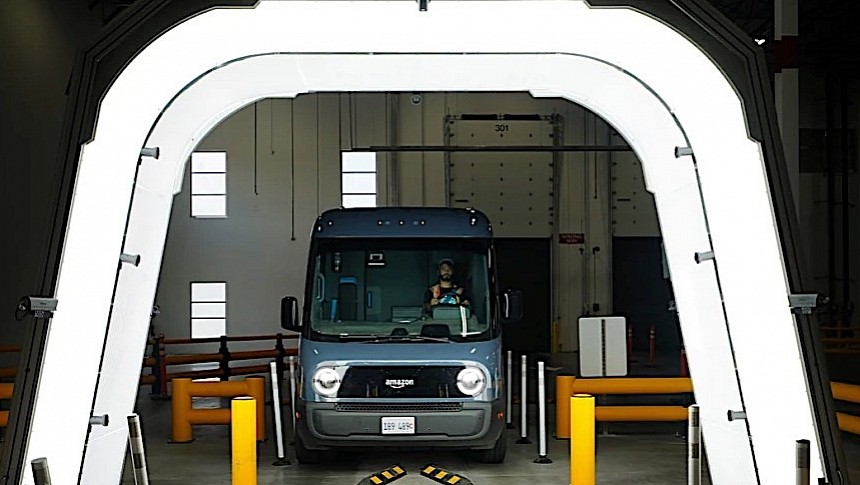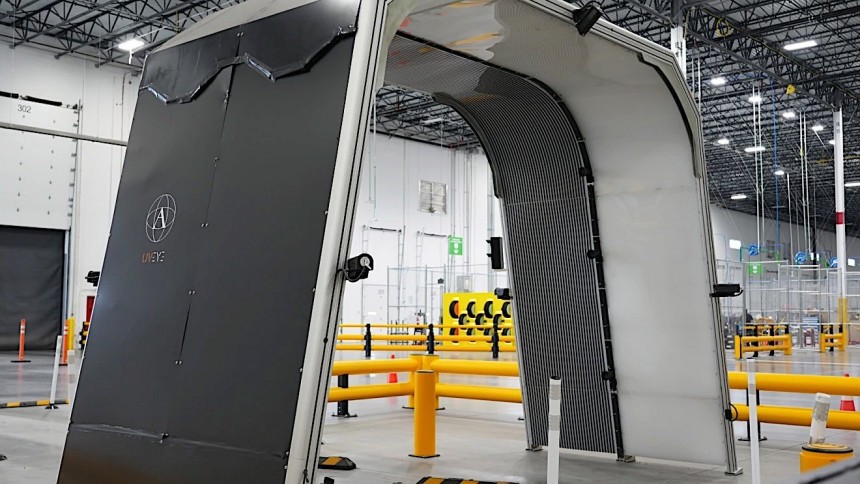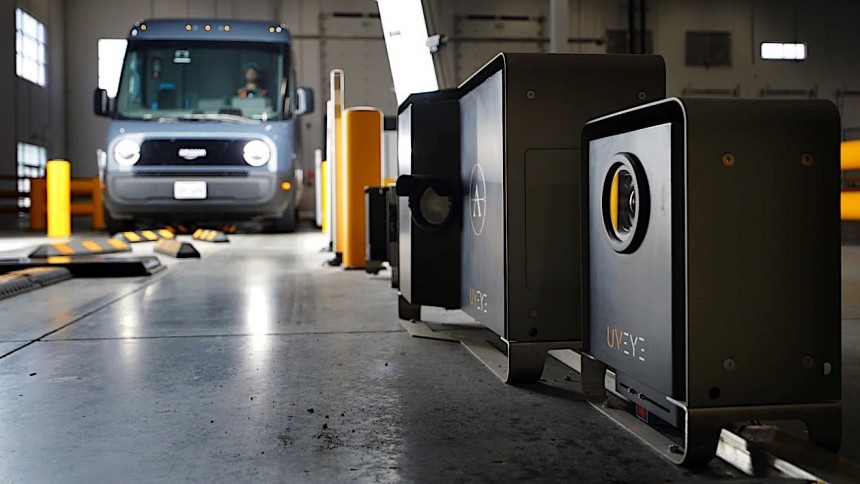Amazon is a business so large that it's almost impossible to wrap your head around it. Just think about its army of delivery partners: over 280,000 drivers take to the road each day to deliver roughly 20 million packages to people all over the world.
Had this army been coordinated from a single place, it would have probably been a logistical nightmare of gargantuan proportions. But Amazon relies heavily on what it calls Delivery Service Partners, third-party companies that make a living from delivering Amazon packages.
These guys are of crucial importance for the online retail behemoth, as without them it wouldn't exist. And delivery companies themselves would not exist without the vehicles they use for transport. Vehicles that need a lot of maintenance and verification, which most of the time is done by faulty humans that can easily miss a problem.
To solve this entire chain of vulnerabilities, Amazon announced this week something it calls the Automated Vehicle Inspection (AVI) system. It's an artificial intelligence technology that was created together with tech startup UVeye with a single goal in mind: scan delivery vehicles and spot tiny problems before they become large, possibly incapacitating issues.
AVI is technically a derivation of the scanners some border and security officers use to look at the underside of a vehicle. After an AI diet, it was transformed into something that can essentially spot many mechanical issue in seconds.
The way AVI is used is as simple as it's effective. Once a driver ends his daily route, they pull into the scanner that looks like an overgrown MRI machine. It consists of an archway that holds cameras and sensors, but also sensor-loaded plates on the ground.
This configuration allows the system to get a 3D view of the vehicle moving through it at speeds of up to 5 mph (8 kph). It takes only a few seconds for AVI to get a complete look at what's going on with the vehicle, and get a decent picture of things that can go wrong.
Because it uses machine learning and a layered neural network, the system can learn as it scans. And it did, as it is now supposedly capable of identifying problems, classifying them based on severity, and sending the results to a computer for them to be looked at by a human.
Amazon says the tech can "spot even the smallest anomalies in Amazon delivery vans," meaning anything from tire deformities to bent or warped body pieces. Why, it can even determine if there are trip-and-fall hazards on a van's cargo steps, and see damage to the hazard lights.
Not only that it can spot them, but can track their evolution, and even determine if a certain type of problem is most likely to develop on a certain route.
Apparently the AI system in the AVI tech Amazon is getting ready to use has been trained with the company's own Roadworthy Guidelines, meaning it will specifically target issues that are known to come in conflict with those rules.
During the testing of the technology Amazon was able to reveal a series of patterns that arise from the extensive use of its and its partners' delivery vans. It found that, most commonly, vans tend to have tire problems (35 percent of issues detected) – anything from sidewall tears to nails lodged in treads.
"The beauty of AI is that each damage is then fed back to an API that can train models and improve detection accuracy. So, the more AVI is used, the better it gets," said in a statement Tom Chempananical, global fleet director at Amazon Logistics.
To do all that learning part, the AVI system is tied into the Amazon Web Services (AWS) system, where it has access to terabytes of vehicle images and data. Because of that, it has the potential to grow to serve more than the purpose of van inspections – it could essentially look an anything people use to move themselves and their cargo around, from something as unpretentious as a bike to complex drones.
"The potential for AVI applications is huge," added Chempananical. "It could also influence our routing and geolocation technology for when we notice repeated vehicle damage happening in the same location."
It may be fresh on the market, but Amazon already has big plans for the technology. It already announced plans to spread it, together with UVeye, for its delivery partners in its largest markets, namely the U.S., Canada, Germany, and the UK.
Amazon did not say how much the deployment of the AVI in service of its partners might cost. For those running large fleets, though, it could be godsent. And probably for car services around the world as well, who just might, in the not-so-distant future, replace the faulty human eye with the AI, and make sure no mechanical issues escape undetected.
These guys are of crucial importance for the online retail behemoth, as without them it wouldn't exist. And delivery companies themselves would not exist without the vehicles they use for transport. Vehicles that need a lot of maintenance and verification, which most of the time is done by faulty humans that can easily miss a problem.
To solve this entire chain of vulnerabilities, Amazon announced this week something it calls the Automated Vehicle Inspection (AVI) system. It's an artificial intelligence technology that was created together with tech startup UVeye with a single goal in mind: scan delivery vehicles and spot tiny problems before they become large, possibly incapacitating issues.
AVI is technically a derivation of the scanners some border and security officers use to look at the underside of a vehicle. After an AI diet, it was transformed into something that can essentially spot many mechanical issue in seconds.
The way AVI is used is as simple as it's effective. Once a driver ends his daily route, they pull into the scanner that looks like an overgrown MRI machine. It consists of an archway that holds cameras and sensors, but also sensor-loaded plates on the ground.
Because it uses machine learning and a layered neural network, the system can learn as it scans. And it did, as it is now supposedly capable of identifying problems, classifying them based on severity, and sending the results to a computer for them to be looked at by a human.
Amazon says the tech can "spot even the smallest anomalies in Amazon delivery vans," meaning anything from tire deformities to bent or warped body pieces. Why, it can even determine if there are trip-and-fall hazards on a van's cargo steps, and see damage to the hazard lights.
Not only that it can spot them, but can track their evolution, and even determine if a certain type of problem is most likely to develop on a certain route.
Apparently the AI system in the AVI tech Amazon is getting ready to use has been trained with the company's own Roadworthy Guidelines, meaning it will specifically target issues that are known to come in conflict with those rules.
During the testing of the technology Amazon was able to reveal a series of patterns that arise from the extensive use of its and its partners' delivery vans. It found that, most commonly, vans tend to have tire problems (35 percent of issues detected) – anything from sidewall tears to nails lodged in treads.
To do all that learning part, the AVI system is tied into the Amazon Web Services (AWS) system, where it has access to terabytes of vehicle images and data. Because of that, it has the potential to grow to serve more than the purpose of van inspections – it could essentially look an anything people use to move themselves and their cargo around, from something as unpretentious as a bike to complex drones.
"The potential for AVI applications is huge," added Chempananical. "It could also influence our routing and geolocation technology for when we notice repeated vehicle damage happening in the same location."
It may be fresh on the market, but Amazon already has big plans for the technology. It already announced plans to spread it, together with UVeye, for its delivery partners in its largest markets, namely the U.S., Canada, Germany, and the UK.
Amazon did not say how much the deployment of the AVI in service of its partners might cost. For those running large fleets, though, it could be godsent. And probably for car services around the world as well, who just might, in the not-so-distant future, replace the faulty human eye with the AI, and make sure no mechanical issues escape undetected.










